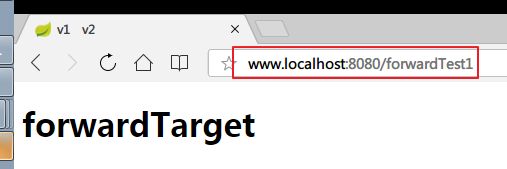Web UI项目中, 很多 Spring controller 视图函数直接返回 html 页面, 还有一些视图函数是要重定向或转发到其他的 url 上.
redirect 和 forward的区别:
重定向 redirect: 完整的重定向包含两次request-response过程, 第一次是访问原始url, 第二次是服务器通知客户端访问重定向后的url. 重定向完成后, 浏览器的地址是重定向后的url, 而不是原始的url.
重定向的使用场景: 因为重定向会修改浏览器地址, 所以 form 提交应该使用重定向, 以免用户刷新页面导致form重复提交.
转发 forward: 完整的转发仅包含一次 request-response 过程, 用户发出request后, 服务器端视图函数先处理自己的逻辑, 然后在服务器端有调用另一个视图函数, 最后将response返回给浏览器.
==============================
转发 forward
==============================
在Spring MVC 中, 构建forward 目标有两种方式:
1. 以字符串的形式构建目标url, url 需要加上 forward: 前缀
2. 使用 ModelAndView 对象来设置转发的forward目标, viewName 可以省略 forward: 前缀, viewName 应该是目标url, 而不是目标视图的函数名.
传参方式:
1. 以字符串的形式构建目标url, 可以使用 query variable的格式拼url
2. 使用 ModelAndView 对象来增加 attribute Object, 其结果也是在拼接url.
取参的方式: 可以使用 @RequestParam 来取参.
==============================
重定向 redirect
==============================
redirect 目标有三种构建方式
1. 使用 redirect: 前缀url方式构建目标url
2. 使用 RedirectView 类型指定目标, 推荐使用这个,
3. 使用 ModelAndView 类型指定目标, ModelAndView 视图名默认是forward, 所以对于redirect, 需要加上 redirect: 前缀
传参和取参方式:
1. 传参: 以字符串的形式构建目标url, 可以使用 query variable的格式拼url. 取参: @RequestParam()来fetch
2. 传参: redirectAttributes.addAttribute() 加的attr. 取参: @RequestParam()来fetch
3. 传参: redirectAttributes.addFlashAttribute() 加的attr. 取参: @ModelAttribute()来fetch
Flash attribute的特点:
1. addFlashAttribute() 可以是任意类型的数据(不局限在String等基本类型), addAttribute()只能加基本类型的参数.
2. addFlashAttribute() 加的 attr, 不会出现在url 地址栏上.
3. addFlashAttribute() 加的 attr, 一旦fetch后, 就会自动清空, 非常适合 form 提交后 feedback Message.
==============================
示例代码
==============================
-----------------------------
pom.xml 和 application.properties
-----------------------------
<dependency> <groupId>io.pebbletemplatesgroupId> <artifactId>pebble-spring-boot-2-starterartifactId> <version>3.0.5version> dependency>
# application.properties file pebble.prefix=/templates/ pebble.suffix=.html pebble.content-type=text/html pebble.cache=false pebble.encoding=UTF-8 pebble.defaultLocale=null pebble.strictVariables=false
-----------------------------
java 代码
-----------------------------
@Controller @RequestMapping("/") public class DemoController { /* * forward 示例: 以字符串的形式构建目标url, url 需要加上 forward: 前缀 * */ @RequestMapping("/forwardTest1") public String forwardTest1() { return "forward:/forwardTarget?param1=v1¶m2=v2"; } /* * forward 示例: 使用 ModelAndView() 设置转发的目标url * */ @RequestMapping("/forwardTest2") public ModelAndView forwardTest2() { ModelAndView mav=new ModelAndView("/forwardTarget"); // 绝对路径OK //ModelAndView mav=new ModelAndView("forwardTarget"); // 相对路径也OK mav.addObject("param1", "value1"); mav.addObject("param2", "value2"); return mav ; } @RequestMapping("/forwardTarget") public String forwardTargetView(Model model, @RequestParam("param1") String param1, @RequestParam("param2") String param2) { model.addAttribute("param1", param1); model.addAttribute("param2", param2); return "forwardTarget"; } /* * redirect 目标有三种构建方式 * 1. 使用 redirect: 前缀url方式构建目标url * 2. 使用 RedirectView 类型指定目标 * 3. 使用 ModelAndView 类型指定目标, ModelAndView 视图名默认是forward, 所以对于redirect, 需要加上 redirect: 前缀 * */ @RequestMapping("/noParamRedirect") public RedirectView noParamTest() { RedirectView redirectTarget = new RedirectView(); redirectTarget.setContextRelative(true); redirectTarget.setUrl("noParamTarget"); return redirectTarget; } @RequestMapping("/noParamTarget") public String redirectTarget() { return "noParamTarget"; } @RequestMapping("/withParamRedirect") public RedirectView withParamRedirect(RedirectAttributes redirectAttributes) { RedirectView redirectTarget = new RedirectView(); redirectTarget.setContextRelative(true); redirectTarget.setUrl("withParamTarget"); redirectAttributes.addAttribute("param1", "value1"); redirectAttributes.addAttribute("param2", "value2"); return redirectTarget; } @RequestMapping("/withParamTarget") public String withParamTarget(Model model, @RequestParam("param1") String param1, @RequestParam("param2") String param2) { model.addAttribute("param1", param1); model.addAttribute("param2", param2); return "withParamTarget"; } @RequestMapping("/withFlashRedirect") public RedirectView withFlashTest(RedirectAttributes redirectAttributes) { RedirectView redirectTarget = new RedirectView(); redirectTarget.setContextRelative(true); redirectTarget.setUrl("withFlashTarget"); redirectAttributes.addAttribute("param", "value"); redirectAttributes.addFlashAttribute("flashParam", "flashValue"); return redirectTarget; } /* * redirectAttributes.addAttribute加的attr, 使用 @RequestParam()来fetch * redirectAttributes.addFlashAttribute()加的attr, 使用 @ModelAttribute()来fetch * */ @RequestMapping("/withFlashTarget") public String withFlashTarget(Model model, @RequestParam("param") String param, @ModelAttribute("flashParam") String flashParam) { model.addAttribute("param", param); model.addAttribute("flashParam", flashParam); return "withFlashTarget"; } @GetMapping("/input") public String input() { return "input"; } /* * form 提交后, 如果form数据有问题, 使用redirectAttributes.addFlashAttribute()加上 flash message. * addFlashAttribute()可以是任意类型的数据(不局限在String等基本类型) * addFlashAttribute() 加的 attr, 不会出现在url 地址栏上. * addFlashAttribute() 加的 attr, 一旦fetch后, 就会自动清空, 非常适合 form 提交后 feedback Message. * */ @PostMapping("/submit") public RedirectView submit(RedirectAttributes redirectAttributes) { boolean passed = false; if (passed==false) { RedirectView redirectTarget = new RedirectView(); redirectTarget.setContextRelative(true); redirectTarget.setUrl("input"); redirectAttributes.addFlashAttribute("errorMessage", "some error information here"); return redirectTarget; }else { RedirectView redirectTarget = new RedirectView(); redirectTarget.setContextRelative(true); redirectTarget.setUrl("inputOK"); return redirectTarget; } } }
==============================
Html 代码
==============================
-------------------------------
input.html
-------------------------------
DOCTYPE html>
<html lang="en">
<head>
<meta charset="utf-8">
<meta name="viewport" content="width=device-width, initial-scale=1, shrink-to-fit=no">
<meta name="description" content="">
<meta name="author" content="">
<title> title>
<link href="https://maxcdn.bootstrapcdn.com/bootstrap/4.0.0-beta/css/bootstrap.min.css" rel="stylesheet" integrity="sha384-/Y6pD6FV/Vv2HJnA6t+vslU6fwYXjCFtcEpHbNJ0lyAFsXTsjBbfaDjzALeQsN6M" crossorigin="anonymous">
<link href="https://getbootstrap.com/docs/4.0/examples/signin/signin.css" rel="stylesheet" crossorigin="anonymous"/>
head>
<body>
<div class="container">
<form class="form-signin" method="post" action="/submit">
<h2 class="form-signin-heading">Please inputh2>
{% if errorMessage is not empty %}
<div class="alert alert-danger" role="alert">{{errorMessage}}div>
{% endif %}
<p>
<label for="username" class="sr-only">Usernamelabel>
<input type="text" id="username" name="username" class="form-control" placeholder="Username" required autofocus>
p>
<button class="btn btn-lg btn-primary btn-block" type="submit">submitbutton>
form>
div >
body>
html>
-------------------------------
inputOK.html
-------------------------------
DOCTYPE html>
<html lang="en">
<head>
<title> title>
head>
<body>
<div class="container">
<h1>inputOKh1>
div >
body>
html>
-------------------------------
forwardTarget.html
-------------------------------
DOCTYPE html>
<html lang="en">
<head>
<title>{{param1}} {{param2}} title>
head>
<body>
<h1>forwardTargeth1>
body>
html>
-------------------------------
withParamTarget.html
-------------------------------
DOCTYPE html>
<html lang="en">
<head>
<title>{{param1}} {{param2}} title>
head>
<body>
<h1>withParamTargeth1>
body>
html>
-------------------------------
noParamTarget.html
-------------------------------
DOCTYPE html>
<html lang="en">
<head>
<title>{{systemName}} {{version}} title>
head>
<body>
<h1>noParamTargeth1>
body>
html>
-------------------------------
withFlashTarget.html
-------------------------------
DOCTYPE html>
<html lang="en">
<head>
<title>{{param}} {{flashParam}} title>
head>
<body>
<h1>withFlashTargeth1>
body>
html>
==============================
效果截图
==============================
转发后的url还是原始请求url, http://www.localhost:8080/forwardTest1
重定向的地址会发生改变, 请求地址 http://localhost:8080/withParamRedirect , 结果地址:
form提交验证的示例: http://localhost:8080/input
开始时的GET 请求截图:
form 提交后的截图:



